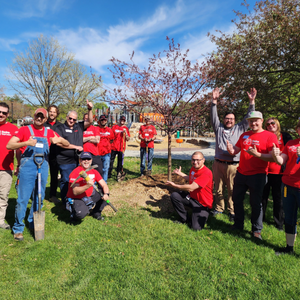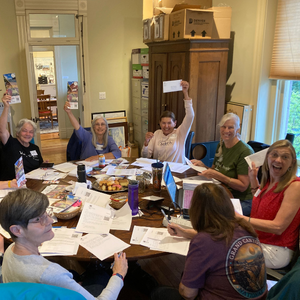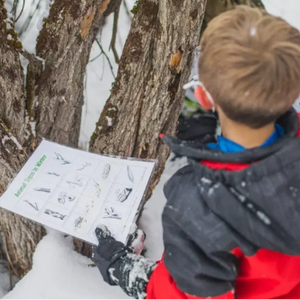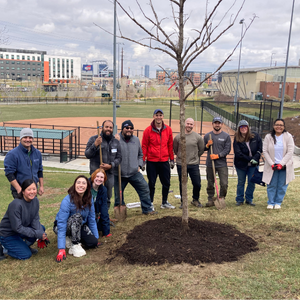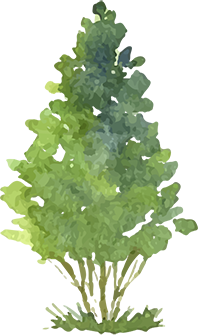FAQ
Getting Free & Low & Cost Trees Through Denver Digs Trees
If you would like to plant at a property within the City and County of Denver, you may apply for free or low-cost trees through our Denver Digs Trees program. We provide both street and yard trees. Tree applications open in early January and are due February 15. Tree pick-up is in April.
If you are not a resident of the City and County of Denver, check out our annual Tree Sale held in conjunction with the Denver Digs Trees distribution.
Street trees are planted in the public space next to the street—usually in the strip between the sidewalk and the curb, or within 10 feet of the curb if there’s no strip. These require a permit, and we’ll will help with that.
Yard trees are planted on private property, 11 feet or more from the curb. They can go in front, side, or back yards.
Both types are available through our Spring tree distribution events!
$15 in Focus Neighborhoods*
$50 in all other Denver neighborhoods
Residents facing financial hardship may request a ‘Treeship’ to receive trees free of charge.
*Focus neighborhoods are selected based on several factors, including particularly low tree cover. Click this link for the list of the current Focus neighborhoods.
Trees of similar stock type and quality typically retail for over $150, so this is a great deal.
Click this link to find out the official neighborhood in which you live.
Focus neighborhoods are neighborhoods where residents receive trees for especially low fees. The neighborhoods are selected based on several factors, including low tree cover. Click this link for the list of ‘Focus Neighborhoods’.
To apply for trees to plant at multiple addresses, please submit a separate application for each planting address. On each application, be sure to enter both your mailing address (where we should send any mailed information about your application) and the appropriate planting address.
Distribution Week: Picking up your Tree(s)
Diameter (caliper) and height vary between species. Most trees are roughly 1.25″ in diameter, and between 6 and 10 feet tall. These trees offer the benefit of being easier to plant, establishing faster and having higher survival rates than larger trees. Estimate 1 year of transplant recovery time for each inch in trunk diameter (e.g. 1 inch tree = 1 year to establish; 2 inch tree = 2 years to establish; 3 inch tree = 3 years to establish, etc).
Tree generally come in 3 types of “packaging”: 1. bare root (no soil around the roots); 2. balled-and-burlapped (soil ball around roots; typically ~45 lbs); 3. container (typically plastic pot with lighter weight growing medium). We order varieties in various forms based on availability and pricing. There are pros and cons to each stock type, but we find great success with all types with proper handling, planting, and care.
A truck or SUV is convenient. However, each year we creatively pack trees into smaller vehicles, including sedans. So, a large vehicle is not necessary unless you are hauling multiple trees. You may choose to bring a tarp or blanket to protect interior upholstery. Remember to drive carefully and slowly (30 mph or slower).
If you cannot personally pick up your tree(s), you have several options:
1) You may send a friend or family member to pick up the tree(s) on your behalf. They will need to present your confirmation ‘Tree Voucher’ email, which you will receive by mid-April, so be sure to forward them the email, or print a copy for them to bring to the distribution site.
2) We offer delivery and/or planting assistance based on need. Please read the application carefully and indicate your request for either “Delivery & Planting Assistance” or “Delivery” only, do not choose both. We have limited resources and depend on volunteers to be able to offer these options. Please note this is not a convenience service, it is reserved for those who are unable to pick up or plant a tree. Thank you.
3) You may contact our office if these options will not work for you, but please note that we have limited resources as we must quickly sell off any unclaimed trees after distribution.
Note: If distribution week conflicts with a religious tradition that you observe and you will not be able to claim your tree, please contact our office.
More About the Trees
Prior to colonization, trees were not a significant part of the natural landscape in the Denver area. Denver is actually considered High Plains and shortgrass prairie, but because of its close proximity to the Rocky Mountains, people often mistake Denver for being naturally forested. However, historically, trees were restricted to riparian areas adjacent to rivers and creeks, as Denver’s arid climate did not provide sufficient moisture for trees to grow in abundance. Trees did not originally grow naturally in Denver, but then again, neither did our city buildings, paved roads, cars, homes, and neighborhoods. We actively plant trees here today because they provide crucial green infrastructure that brings ecological balance to our built environment—our paved surfaces and our urban ecosystem. While they weren’t naturally occurring here in abundance, they are a critical nature-based solution to our local and even global environmental challenges. By planting trees in Denver now, and supporting forestry departments, private tree care companies, and training tree stewards, we are adapting to rising temperatures and making our city livable, for people and for urban wildlife. They beautify our neighborhoods, improve property values, and support good health by encouraging us to spend time outdoors. They also provide habitat for wildlife, slow rain run-off to reduce flooding, filter air pollution, and cool our communities with their shade, which conserves energy and saves us money. Trees improve our quality of life!
Yes, we do plant native trees! Western Hackberry and Serviceberry are two of our favorites, and they often appear on our distribution lists. However, truly native species are limited, especially ones that thrive in urban settings. For example, Cottonwoods are great in natural areas but can become hazardous as they age, and native conifers can block visibility along streets.
We aim for a diverse, resilient urban canopy. Over-reliance on a few species—like Ash trees in the past—can backfire. Now, with the Emerald Ash Borer in Colorado, up to 16% of Denver’s canopy is at risk.
When choosing trees, we consider public safety, maintenance, biodiversity, cost, and urban compatibility. Many non-native trees we plant still support local wildlife and provide significant benefits to our communities.
Check out our recommended trees and resources on our Community Resources page!
Street trees are planted in the public space along streets, usually in the area between the sidewalk and the curb (called the “tree lawn”). If there’s no tree lawn, they can be planted within 10 feet of the curb.
Although this is city property, the adjacent property owner is responsible for caring for the tree. Because street trees are on public land, a permit is required before planting.
Important: As of 2023, rock mulch must be removed from the planting area. A 5-foot area around the tree must be clear of rock or concrete to help roots grow. Rock mulch traps heat and worsens drought stress, making it harder for trees to survive.
A “Shade Tree” typically refers to a medium or large tree, often with a spreading canopy, which provides significant shade. A strategically planted shade tree can reduce the amount of energy needed to cool your home during the warm months, resulting in lower energy bills and less carbon released into the atmosphere. In the fall, these deciduous trees drop their leaves, allowing winter sunlight to pass through and warm your home.
An “Ornamental Tree” typically refers to a tree of a small mature size, generally 25 feet tall or shorter. Ornamental trees often have attractive features, such as showy flowers.
We work closely with the Denver Office of the City Forester to select species appropriate for Colorado’s arid climate and our urban environment. Most of our selections are relatively drought and cold hardy once established. We also select species for their disease resistance. We work to offer a variety of different species to build the diversity of the city forest – the best approach to combating disease and other threats to individual tree species. As new tree varieties are developed and new pests and diseases emerge, Denver Forestry staff helps us make wise decisions for the future of our urban forest.
Dependant on availability and affordability, we are able to occasionally offer fruit trees, including apples, cherries, pears, peaches, and plums, during our Fruit & Yard Tree Sale held in conjunction with the Spring Tree Distribution. The cost is typically $50-$100 (about 60% discount from retail nursery price). As of 2022, the City and County of Denver allows fruit trees to be planted in the public right-of-way. So fruit trees may occasionally be part of the list of available species through the main Denver Digs Trees distribution.
Planting Your Tree
Click here for Planting Instructions.
Must haves: shovel, utility knife (or scissors), water source, hose or bucket, mulch*
Handy to have: tarp to pile soil on, pickaxe in case of tough soil or roots
*Denver Digs Trees applicants will receive a free bag of mulch along with their tree on pick-up day.
We strongly advise you to plant your tree(s) immediately. If you cannot plant right away, you must keep the roots from drying out (particularly a challenge with bare root trees, so get those babies in the ground!).
We do not recommend digging your tree’s hole in advance because you will base the size of the hole on the tree’s rootball or root system (digging twice as wide but at roughly the same depth). It’s like trying to pick out shoes before trying them on! One of the most common mistakes is planting too deeply, which suffocates the tree and often shortens a tree’s lifespan. So, it’s important to get that depth right and base it on the tree’s anatomy (see Planting Instructions).
We do not recommend amending the soil in your planting hole with fertilizer or compost. Improving the soil in this way creates a pleasant environment for the tree’s roots just within the planting hole, discouraging the roots from spreading out into the surrounding soil. Thus, instead of developing healthy roots that expand outward and anchor the tree, the roots may grow much like a potted plant, girdling (strangling) themselves and making the tree vulnerable to winds and weight. Instead, consider topdressing the entire surrounding lawn area with compost to improve the overall health of your soils and encourage your tree’s roots to grow outward.
We do not generally recommend staking trees unless necessary (i.e. the tree will not stand straight on its own, more often an issue with bareroot trees than balled-and-burlapped and container trees). Too often, staking materials serve no necessary function and are left on too long, resulting in a girdled (strangled) trunk and a dead tree. Also, many people tie stakes to trees too tightly, so the trees do not sway in the breeze. This prevents them from developing the strong tissue structures that make them adaptable to strong winds. So, if your trees stand straight on their own, avoid staking them. Visit this link for recommended staking techniques.
To protect the thin bark of young trees from sunscald in the winter, in November you should wrap trees upward from the base of the tree to the lowest branches for the first three years. Sunscald can result when the dormant cells of young trees become activated by high intensity sunlight, at a lower angle in the winter months. As the temperature drops after sunset or with a change in the weather, these active cells are killed, leaving a wound on the tree.
Be sure to remove the wrap in April to prevent girdling (strangling) and potential insect damage.
Caring for Your Tree
Click here for Tree Care Instructions.
For questions about your young trees, please reach out to The Park People’s Certified Arborsit at Treecare@theparkpeople.org. For questions about exisitng large trees, The City of Denver’s forestry inspectors within the Office of the City Forester provide education to residents about tree care and health issues. They can answer almost any question you may have about trees. The inspectors can answer questions via phone and email and also schedule site visits for some issues. They are also tasked with issuing permits and enforcing regulations surrounding the planting and removal of trees. So you may contact them directly to request a street tree planting permit if you are planting on your own, outside of Denver Digs Trees. Find your forestry inspector.
Yes. In Denver, anyone performing tree care services, including pruning and removal, must be licensed as a “Tree Service Company.” The City of Denver’s Forestry Division provides a current list of companies licensed to perform tree work in the City & County of Denver.


